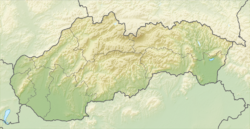- Veľké Dvorníky
-
Veľké Dvorníky
Nagyudvarnok— village — Location of the village Coordinates: 48°00′00″N 17°39′00″E / 48°N 17.65°ECoordinates: 48°00′00″N 17°39′00″E / 48°N 17.65°E Country  Slovakia
SlovakiaRegion Trnava District Dunajská Streda First written mention 1162 Named for Aba (old Hungarian name) Government[1][2] – Mayor Ernő Tóth (Party of the Hungarian Coalition) Area – Total 7.990 km2 (3.1 sq mi) Elevation 114 m (374 ft) Population (2001)[3] – Total 795 – Estimate (2008) 959 – Density 120/km2 (310.8/sq mi) Etnicity[3] – Hungarians 95,85 % – Slovakians 3,14% Time zone EET (UTC+1) – Summer (DST) EEST (UTC+2) Postal Code 929 01 Area code(s) +421 31 Website Municipality website (Hungarian) (Slovak) Veľké Dvorníky (Hungarian: Nagyudvarnok, Hungarian pronunciation:[’nɒɟudvrnok]) is a village and municipality in the Dunajská Streda District in the Trnava Region of south-west Slovakia. Its former Slovakian name Dvorníky na Ostrove.
Contents
History
The village was first recorded in 1162 as village inhabited by people with Udvarnok social status which meant half-free people in the service of the kings of Hungary and Pozsony Castle. Until the end of World War I, it was part of Hungary and fell within the Dunaszerdahely district of Pozsony County. After the Austro-Hungarian army disintegrated in November 1918, Czechoslovakian troops occupied the area. After the Treaty of Trianon of 1920, the village became officially part of Czechoslovakia. In November 1938, the First Vienna Award granted the area to Hungary and it was held by Hungary until 1945. The present-day municipality was formed in 1940 by unifying the three component villages. After Soviet occupation in 1945, Czechoslovakian administration returned and the village became officially part of Czechoslovakia in 1947.
Demography
In 1910, the village had 389, for the most part, Hungarian inhabitants. At the 2001 Census the recorded population of the village was 795 while an end-2008 estimate by the Statistical Office had the villages's population also as 959. As of 2001, 95.85% of its population was Hungarian while 3.14% was Slovakian.
Roman Catholicism is the majority religion of the village, its adherents numbering 91.95% of the total population. [3]
Geography
The municipality lies at an altitude of 114 metres and covers an area of 7.991 km².
References
External links
- Local news selection at Új Szó on-line (Hungarian)
- Local news selection at www.parameter.hu (Hungarian)
- Mestá-Obce.sk (Slovak)
- Postcard showing the village
- Local football club
- The Garden of the Castle
Dunajská Streda • Šamorín • Veľký Meder
Báč • Baka • Baloň • Bellova Ves • Blahová • Blatná na Ostrove • Bodíky • Boheľov • Čakany • Čenkovce • Čiližská Radvaň • Dobrohošť • Dolný Bar • Dolný Štál • Dunajský Klátov • Gabčíkovo • Holice • Horná Potôň • Horné Mýto • Horný Bar • Hubice • Hviezdoslavov • Jahodná • Janíky • Jurová • Kľúčovec • Kostolné Kračany • Kráľovičove Kračany • Kútniky • Kvetoslavov • Kyselica • Lehnice • Lúč na Ostrove • Macov • Mad • Malé Dvorníky • Medveďov • Michal na Ostrove • Mierovo • Nový Život • Ňárad • Ohrady • Okoč • Oľdza • Orechová Potôň • Padáň • Pataš • Povoda • Rohovce • Sap • Štvrtok na Ostrove • Topoľníky • Trhová Hradská • Trnávka • Trstená na Ostrove • Veľká Paka • Veľké Blahovo • Veľké Dvorníky • Vieska • Vojka nad Dunajom • Vrakúň • Vydrany • Zlaté Klasy Categories:
Categories:- Villages and municipalities in Dunajská Streda District
- Hungarian communities in Slovakia
Wikimedia Foundation. 2010.

